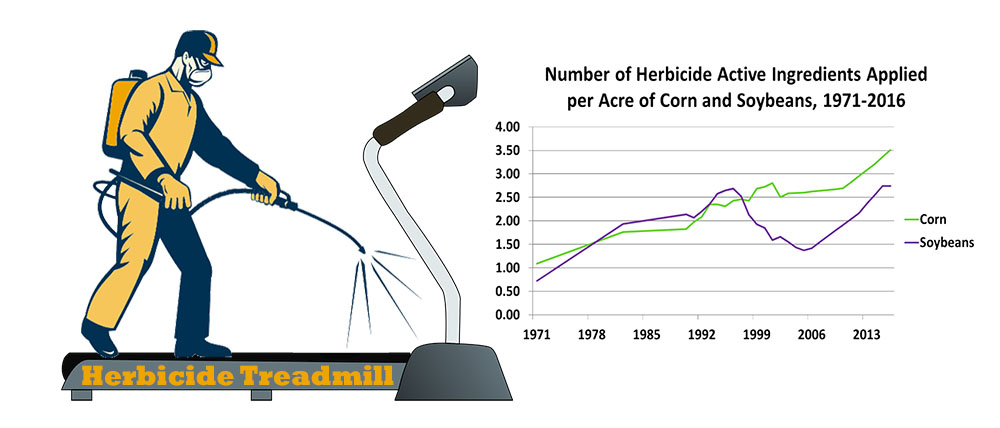See also:
Introduction
Modern industrial agriculture relies heavily on large, monoculture fields with the two main crops- corn and soybeans- grown on a two-year rotation. Chemical herbicides and fertilizers are heavily used to support this intensive agriculture. Extensive herbicide use leads to weed resistance and very quickly we find ourselves stuck on the herbicide treadmill.

However, even as billions of dollars and millions of acres of American farms are dedicated to the industrial ag complex that led us to be stuck on this treadmill, many researchers are finding that bringing back old-fashioned farming methods, but guided my modern science, could give us the boost we need to get off the treadmill.
We look some of the alternative farming systems that show promise for reducing herbicide use while still maintaining the high yields needed to feed the country and the world.
Diversified Cropping Systems
Before the advent of modern agriculture, farmers used crop rotations to get the most out of each acre. In particular, growing a forage crop like alfalfa in rotation with soybeans and corn helps control weeds and boost soil quality. These perennial crops put in a solid root system that prevents erosion, and legume forages like alfalfa are nitrogen fixers which capture atmospheric nitrogen, enriching soil health.
These extensive root systems also build organic matter in the soil, and prevent weed infestation. Plus, they even sequester carbon- some ranchers are starting to get into the carbon credit market. A year or two rotation of alfalfa, or even just a winter cover crop, can make a big difference.
Plus, research shows that diversified cropping systems can produce similar yields to the conventional two-year corn-soy rotation, without the costly inputs of agrichemicals. In one key study, published in 2012, USDA weed and soil scientist Adam S. Davis and his team published results of a 8-year long field study. They compared the yields and costs of producing crops under the conventional methods with a 3 year and 4 year rotation with combinations of corn, soy, small grains, clover, and alfalfa. The diverse cropping systems produced similar crop yields and quality, with substantially less inputs of chemical fertilizers and herbicides (Davis et al., 2012).
Other resources:
- 2018 Hot Science post, “Diverse Cropping Systems Result in Higher Yields and Lower Greenhouse Gas Emissions”
- Hygeia’s Blog, “Alfalfa — The Crop That Don’t Get No Respect,” 2018
- “Grasses Are Like Straws Sipping Carbon from the Air,” 2018 blog on a New York Times piece about the Marin Carbon Project
- 2017 In the News post about Ray Archuleta, USDA guru on soil conservation and true believer in the power of cover crops
- Research published in 2004 about the importance of cover crops
Organic Farming
- Click here to view related documents
- Hunter College’s New York City Food Policy Center did an excellent deep dive in their article “Is the Organic Label as Valuable as You Thought?” (2018)
- 2016 blog post, Organic Farming Improves Soil Quality
- The Organic Center Critical Issue Report: “Organic Food and Farming as a Tool to Combat Antibiotic Resistance and Protect Public Health,” 2015
- Plant breeding for more productive organic crops, peer-reviewed paper published in 2015 in Trends in Plant Science
- 2015 paper in PeerJ “Significance and value of non-traded ecosystem services on farmland”
- “Financial competitiveness of organic agriculture on a global scale” from 2015 in Proceedings of the National Academy of Sciences
- 2014 article in the Proceedings of the Royal Society B, “Diversification practices reduce organic to conventional yield gap”
- Washington State University Extension Fact Sheet, “2010 Cost Estimates of Establishing and Producing Organic Apples in Washington”
- 2010 Critical Issue Report by The Organic Center, What Does Sustainable Agriculture Have to Offer? Conclusions and Recommendations in Two NAS/NRC Reports
- 2006 PNAS article, “Reduced nitrate leaching and enhanced denitrifier activity and efficiency in organically fertilized soils”
- 2006 paper in Horticultural Science comparing apple orchard productivity and fruit quality under different farming systems
- “Sustainability of three apple production systems,” 2001 article in Nature
- Rotenone Use in Organic Farming
- Rodale Institute Farming Systems Trials – 30 Year Report and brochure
- The Organic Center’s State of Science Review on energy use of organic and conventional ag
- “Organic and Conventional Agriculture Reconsidered,” 2005 Letter to the Editor in BioScience
